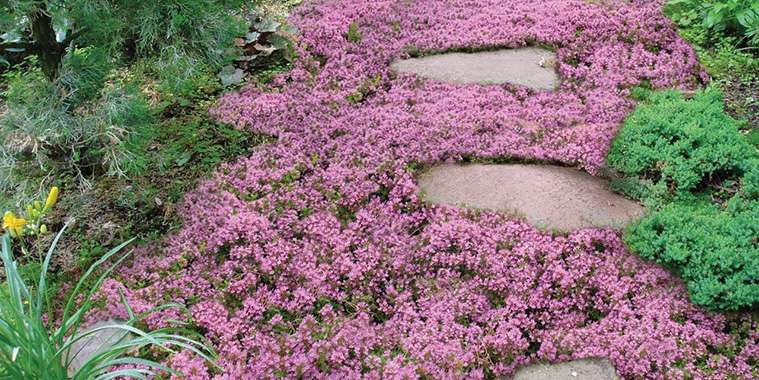Thyme is a wonderful herb used in cooking but also in many medicinal and cosmetic products. Today, turmeric is the herb of the moment, but thyme packs a powerful wallop of nutrition to your daily diet. In just 100 grams of thyme leaves you will find a lot of your recommended daily allowance of vitamins and minerals: 38% of dietary fiber, 27% of vitamin B-6 (pyridoxine), 266% of vitamin-C, 158% of vitamin A, 218% of iron, 40% of calcium, 40% of magnesium, and 75% of manganese. 100 grams of thyme delivers 100 calories.
There are over 300 varieties of thyme but common thyme (Thymus vulgaris) is most often used in cooking. Thyme is also known by a myriad of other names such as English thyme, French thyme, summer thyme, winter thyme and garden thyme.
Other frequently used varieties of thyme include the pretty, variegated lemon thyme, the stately mother of thyme, and low growing creeping and woolly thyme. The latter two both make wonderful groundcovers and are sometimes used to create fragrant pathways through a garden; walking on them only embeds the roots into the soil, encouraging more growth.
Woolly thyme is famous for its oils, but it also makes a particularly beautiful groundcover with it fuzzy blue-green leaves and pretty pink flowers. It provides a nice tight cover, one to three inches tall, on a dry, sunny location.
Thyme is a powerful anti-oxidant, and it is also both antiseptic and antifungal. It was used by the Egyptians in embalming; by the Greeks in their baths and burned as incense; by the Romans to flavour cheese and liqueurs. Middle Ages Europeans placed thyme under pillows to aid sleep and to stave off nightmares. It was placed on coffins because it was thought that thyme would aid a soul to pass on to the next life. It was given to knights as a sign of courage.
Medicinally, thyme had a wide range of uses and is still found in non-alcoholic hand sanitizers, in mouth washes (including Listerine), and toenail fungus compounds. A tea made of hot water and thyme will aid coughs and sore throats. For many years it was used to medicate bandages.
Thyme has many culinary uses, and of all the herbs, it is the one most amenable to drying. It keeps as oils and fragrance. Just hang a few sprigs in a cool, dry place.
In cooking, one sprig of fresh thyme is equal to about one-half teaspoon of dried thyme. It is sweetest when picked just before flowering.
Thyme goes well with meat, fish, tomatoes, roasted potatoes, eggs, eggplants, and peppers. Before using, crush the leaves between your palms to release the oils. It pairs well with rosemary and sage.
Grow thyme in well-drained, gritty soil and do not overwater.
For those of you who remember 1968, thyme was also mentioned in the second line of the Simon and Garfunkel song “Scarborough Fair”:
“Are you going to Scarborough Fair,
Parsley, sage, rosemary and thyme.
Remember me to the one who lives there,
She once was a true love of mine.”
Parsley was for comfort, sage was for strength and wisdom, rosemary for love and remembrance and thyme was for courage.
Dorothy Dobbie is the publisher of Manitoba Gardener magazine. Listen to her weekly radio show on Nostalgia Radio, CJNU 93.7 FM at 8:00 Sunday mornings at 8:00.



